Remember my post on ‘Doilie, doily, doyley, doiley, d’oyley’ etc? Less than a month after I wrote it, sometime in late June or early July 2011, this showed up at a local op shop:
It’s a doyley holder!
Naturally, I wanted it! But I didn’t need it, and the op shop wanted $30 for it, which I thought was ridiculous, and which I couldn’t afford for something that I really don’t need. And it was an op shop where I won’t spend silly money just to support the charity (there are ones where I will spend more because I think the cause is really worthwhile, and the money well spend, but this one spends too much on paying its CEO and advertising)
So I waited, and waited, and waited.
The doyley holder didn’t sell.
Finally, in January of this year, after it had sat in the op shop for 18 months, they replaced the $30 label with a $20 one, but that was still too pricey for me.
So I waited, and waited, and waited.
In June, the price got dropped to $15, and I was very tempted, but still thought it was a lot of money.
So I waited, and waited, and waited (maybe not quite as long as last time).
In October, the price was dropped to $10. I almost bought it, but in all that wait the doyley holder had been damaged, and the leather strip that holds the two sides together had been ripped through. And the label had been put on with tape, so would rip the inside when it was removed. Bummer.
But the week before Christmas I was in the op shop again, and there was the doyley holder, marked down to $5. That I could afford!
So, two-and a half years after my post, and after I first spotted it in the op-shop, I finally have my doyley holder, and can show it to you!
I think it dates to the ’30s-’50s, based on the marbleized paper in the middle, which I associate with the ’30s & ’40s, and the Made in England dome that fastens it. It’s probably not WWII era, but immediately pre or post is an option. After the 50s things like doilie holders get pretty scarce. What do you think?
And where is it a souvenir of? Is that supposed to be the Sydney Harbour Bridge?
Now I just need to decide what to do with it? Should I sympathetically mend the broken hinge? Should I actually store my doilies (well protected by acid free tissue) in it?

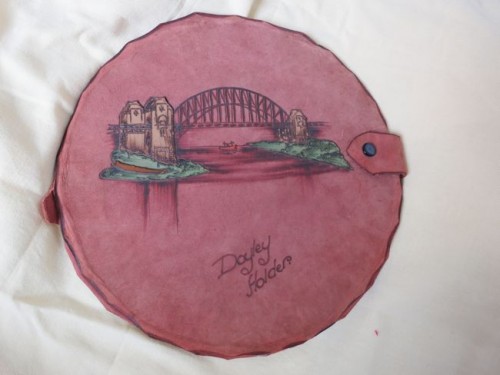
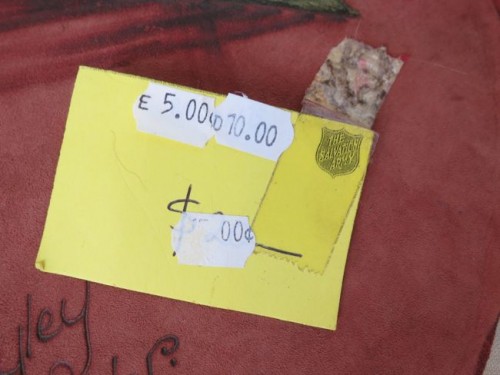
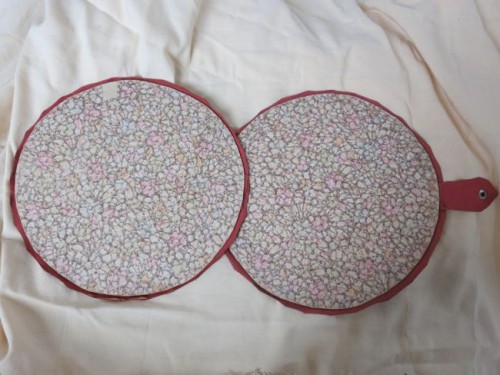
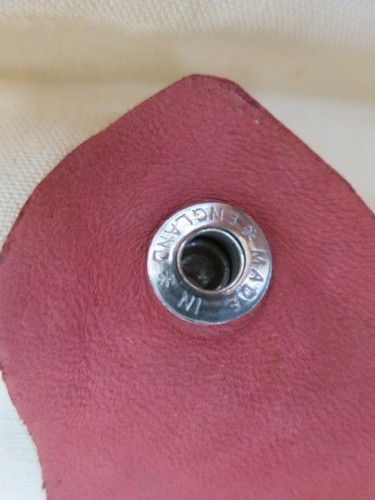
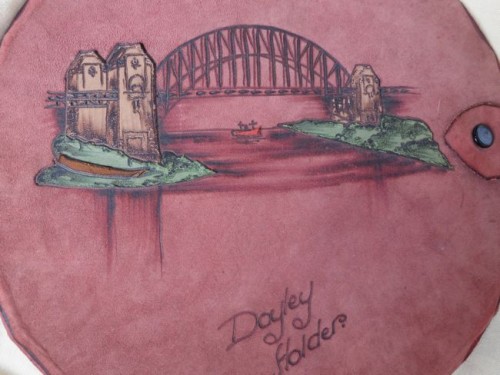
Fantastic !
It looks 1920s to me. My grandmother had a cute little souvenir that had similar styling, and the paper says 1920s to me. Leather stumped souvenirs were super popular, and that font is darling!
Good for for being patient on the price! It was worth it!
I don’t think as early as ’20s, but I am leaning towards the earlier date.
I don’t usually have the luxury of being so patient about price – things go even at ridiculous prices, but I’m glad I waited this one out!
I don’t really know how to advise you on whether to repair it, since I don’t know what it’s value would be, unrepaired. I do think you should do what you can to preserve it, because it is a little corner of textile history and has educational value (as evidenced by this post).
And congratulations on acquiring it at a price you could easily afford! I have a (roughly) similar story.
Years ago, I was looking for a particular book on the history of Ukrainian costume. It is a slender book with wonderful drawings (that was published by a small press in Australia, thus nearly impossible to find in the eastern U.S.) and I stalked it for years on the Internet.
Finally, I saw it on Ebay (not usually the best place to get books, in my opinion) with a low minimum bid. So I bid on it. Someone bid against me, and we bid the price up until it got to $40–which was the absolute most I was prepared to pay for it at the time. The book went to the other bidder for (I think) $46.
About 10 days later, I got e-mail from the seller. She told me that the winning bidder had reneged or something, and was I still interested in the book at my high bid of $40? Naturally, I was. So the book is doubly satisfying to me.
Changes in monetary value repaired or unrepaired are irrelevant to me – I’m just trying to balance stabilising and taking care of it vs. changing and damaging it. The usual restoration vs. conservation argument.
What a lovely story about the book. I’m so pleased you got it. These days of course you could ask those of us in the antipodes to keep a watch out for you!
Yes, thank you! If I do go looking for a book published in Australia or NZ, I’ll be certain to post.
That is patience!
And the restraint of telling myself “you don’t need it…” for two years 😉
Wow, what a wait, and it’s so cute! Store doilies in it I think…
Isn’t it charming! I’m trying to think of a way to display it and store doilies at the same time…
There are three bridges in the world that look like that, the Sydney habour, the Tyne Bridge in England and the Hell Gate Bridge in New York. The Hell Gate Bridge is the original and the Tyne and then Sydney Harbour bridges where built after it’s style in that order and I believe the same firm built both.
I think it looks the most like the Sydney Harbour bridge, in the shape of the towers. Sydney Harbour bridge was completed in the early 1930’s, so a souvenir of it is less likely to originate from earlier.
Thank you. The towers made me think Sydney Harbour rather than the other two as well. And the 1932 completion of the SHB is why I dismissed an earlier date for the doily holder, though I have seen earlier examples of that marbled paper.
What a story, and what a win! I have never seen one before – we just kept them in the linen cupboard, in a doily heap.
I think Cate is right about its being Sydney Harbour Bridge, and about its being 1930s. That would make sense.
It also makes a lot of sense that it’s from Sydney, being as how you found it in New Zealand.
Well done for not only being able to buy it, but also for writing about it and sharing this knowledge with others!
You’d think so, because of the proximity, but actually I find far more pre-1950s souvenirs from Europe in NZ than ones from Australia. I don’t think Oz was exotic enough for souvenirs in the minds of most Kiwis! So if it is the SHB this one is that much more exciting!
And thank you!
I’ve seen a few doily holders before, both solid ones like this, and soft cloth bags. Old magazines and workbooks from the 1890s-1930s are full of designs and suggestions for them, but I think more got designed than made because they weren’t that necessary!
I used to frequent some thrift shops that discounted items weekly if they didn’t sell. I called it my version of Las Vegas, gambling on whether or not I’d get that great item at a price I could afford. I even kept a little notebook of items, dates, and prices. It adds to the fun.